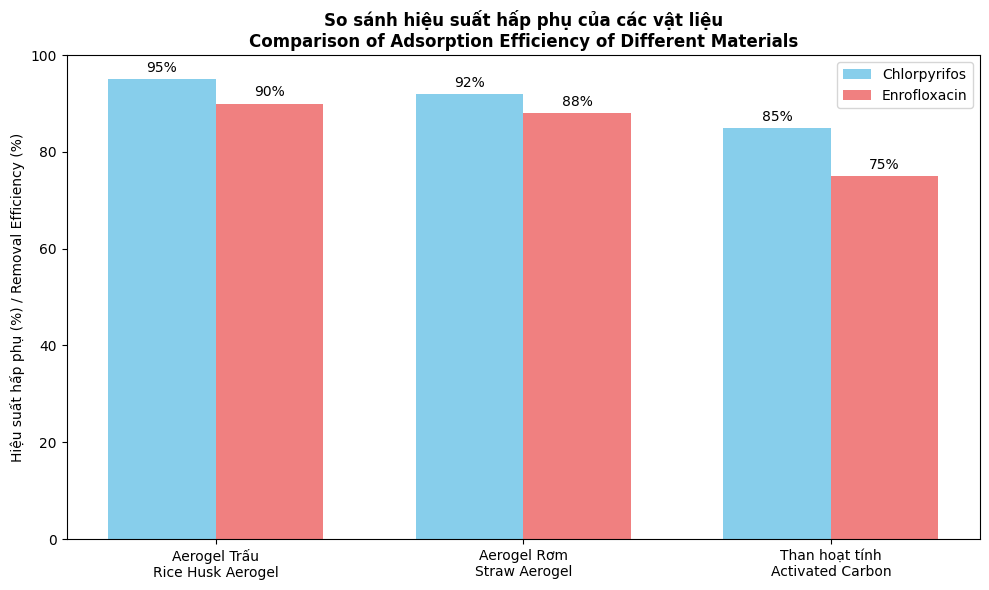Introduction
The Mekong Delta (MKD), Vietnam's largest rice granary and aquaculture hub, is facing a serious environmental challenge: pollution from antibiotic and pesticide residues. The overuse of these chemicals in cultivation and animal husbandry has led to their persistence in soil, water, and agricultural products, directly threatening the ecosystem and public health. In this context, research into effective, low-cost, and environmentally friendly adsorbent materials becomes imperative. One promising direction is leveraging the abundant local agricultural by-products to synthesize aerogel - a "super material" of the 21st century - for application in adsorbing and removing these pollutants.
The "Golden" Potential from Wasted By-products
Annually, the MKD generates a massive volume of agricultural by-products. It is estimated that rice straw and husks alone amount to over 20 million tons (World Bank, 2020). Most of this is often burned, causing air pollution, or left to decompose naturally, wasting a valuable resource. The nature of these by-products is their high cellulose and silica content, making them ideal "raw materials" for producing aerogel through a technological process.

Figure 1: Diagram of the Aerogel Production Process from Agricultural By-products
Aerogel, dubbed "frozen smoke," possesses a unique structure with a nanoscale porous network, an extremely large specific surface area (can reach up to 1000 m²/g), and ultra-low density. When fabricated from biological sources, cellulose/silica aerogel inherits all these superior properties, while also being biodegradable and, most importantly, very low-cost. The advantage in raw material cost is clearly illustrated in the chart below:

Chart 3: Comparison of Raw Material Costs for Adsorbent Production
This opens up immense potential for a circular economy: transforming waste into pollution treatment materials, thereby contributing to the protection of the very agricultural production environment.
Practical Application in Pollution Treatment in the MKD
Statistical data from 2010 to the present paints an alarming picture of pollution in the MKD. Chart 1 below shows the increasing trend of these pollutants in the water environment.

Chart 1: Trend in Detection Frequency of Residues in Water Samples in the MKD (2010-2023)
Specifically, Table 1 provides data on the average concentration of some typical pollutants, showing that they frequently exceed permissible limits.
Table 1: Average Concentration of Selected Pollutants in Surface Water in the MKD (2010-2023)

The ultra-microporous structure of aerogel makes it a perfect "molecular trap" for addressing this issue. Figure 2 below illustrates the potential application model of aerogel in practice.

Figure 2: Model of Aerogel Application in Treating Agricultural Wastewater in the MKD
Laboratory research using aerogel from MKD rice straw and husks has shown very high adsorption efficiency. This material not only can remove over 90% of some common antibiotics in tra catfish pond wastewater (CARES, 2021) but also effectively adsorbs hard-to-degrade pesticides. Chart 2 compares the performance of aerogel with the traditional material, activated carbon, showing the clear advantage of aerogel.

Chart 2: Comparison of Adsorption Efficiency of Different Materials
Conclusion and Prospects
The potential for applying aerogel from agricultural by-products to treat antibiotic and pesticide residues in the MKD is vast. This solution not only addresses the dual problem of agricultural waste management and water environment pollution but also aims for a circular and sustainable agriculture. However, to turn this potential into reality, further investment in research is needed to optimize the production process, minimize costs, and conduct pilot-scale trials before wider field deployment. With the advantage of local raw materials and the urgency of the environmental issue, bio-aerogel deserves to be a focus of science and technology aimed at the sustainable development of the Mekong Delta region.
References
- Ministry of Natural Resources and Environment (MONRE). (2022). *National Environmental Status Report 2016-2020: Special Report on Mekong Delta.*
- CARES (Centre for Agriculture, Aquaculture and Rural Research). (2021). Assessment of Antibiotic Residues in Aquaculture Systems in the Mekong Delta, Vietnam.
- Nguyen, H. P., et al. (2019). "Occurrence and risk assessment of pesticides in surface water of the Mekong Delta, Vietnam." Environmental Science and Pollution Research, 26, 25054–25066.
- World Bank. (2020). Vietnam - Toward a National Strategy for Sustainable Agriculture Transformation in the Mekong Delta.
- Tran, T. K., et al. (2020). "Cellulose-based aerogels from rice straw for oil spill cleanup and dye adsorption." Journal of Porous Materials, 27(3), 789-800.
- Le, T. M., et al. (2018). "Antibiotic contamination in the Mekong River Delta, Vietnam: Sources, occurrence, and potential risks." Emerging Contaminants, 4(1), 13-20.